Several years ago I worked with a person who was invited to lead a traditional organisation. His brief was to shift the culture and make it fit for purpose.
The Board asked him to take over because he was known for delivering success. They said:
“We love your energy and innovative approach. We must embrace those qualities to survive in the modern world.”
Arriving on the first day, he was given a tour of the building. He was then told:
“We have put together a plan for your first two months. Here is a schedule of all the committees you need to attend.
“The diary looks full, but it is important that you meet these people and attend these functions. We are sure that you can use your personality to win over even the toughest doubters.”
The person attended some functions, but then created a different schedule. Within six months he had delivered a superb campaign that won national recognition for the organisation.
The success was not appreciated, however, because he had failed to use the organisation’s traditional channels. He left to do imaginative work that has been lauded across the world.
Many innovators choose to spend time away from institutions. The institution may be a building, organisation or other body that has an ambivalent attitude towards creative thinking.
Some innovators may still belong to an organisation, but they create some kind of distance. This may be a physical distance, such as working at home or in their own laboratory. Or it may be a psychological distance, such as doing things differently.
Looking back on your own life, when have you managed to be innovative away from some kind of institution? What did you do to set aside the time and space to think and create?
Different people do this in different ways. They may work as a freelancer, take a gap year, embark on a study tour, have their own personal side project, work at home one day a week or whatever.
If you wish, try tackling the exercise on this theme. This invites you to do the following things.
Describe a specific situation in the past when you were able to be innovative away from an institution.
Describe the specific things you did to be innovative away from the institution.
Describe the specific things that happened as a result of taking these steps.
There are many ways to be innovative, but these often call for people having the freedom to think and breathe. People need to spend time focusing on creative solutions, rather than trying to persuade committees. Buckminster Fuller said:
“You never change things by fighting the existing reality. To change something, build a new model that makes the existing model obsolete.”
Sometimes it is easier to make this happen when breathing the fresh air. One person said:
“I spent years working inside organisations trying to persuade people to change. But I was battling against the nature of systems theory.
“Systems move towards homeostasis – the drive to return to their present state. Sometimes this can be good, because it can create stability. But sometimes it can be dangerous, because it can prevent development.
“Systems sometimes drive out the creativity they need to survive. So I have found other ways to develop new ideas.”
Different people use different approaches to being innovative. One approach is to start by defining the real results to achieve – the desired impact. It is then to go through the stages of innovation, implementation and achieving the desired impact.
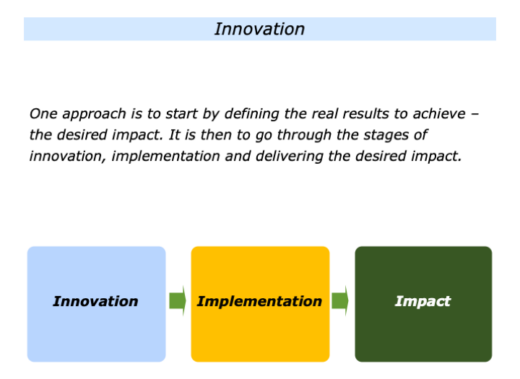
“This sounds challenging,” somebody may say. “Is there any way it is possible to be innovative within an existing institution?”
Certainly it is possible, but the organisation must be really serious. Some have championed approaches such as Intrapreneurship, for example, to nurture creative ideas within their organisations.
Some creative people have also developed another methodology for revitalising an organisation. This can be equated to building a house.
Some people renovate an existing house. Some build a new house that is connected to an existing house. Some build a new house in a new place. Some combine elements of all three approaches.
Renovating
An Old House
Revitalising an existing house – or an organisation – can be challenging. Sometimes changing a system meets resistance. Too much time can be spent trying to persuade people, rather than delivering the required results.
It is possible to revitalise an organisation, but this can be painful. Sometimes it is more effective to take the following approach.
Building a new house that is
connected to an old house
Kate is somebody who has followed this route. She has built new houses – new ways of doing things – that have been connected to existing organisations.
She has led teams that developed new approaches to customer service for companies in the travel, insurance and digital sectors. Kate has often done this by taking the following steps. She aimed:
To get a clear picture of success and mandate from the Board;
To clarify what had worked best in the company and show respect for its heritage;
To connect the new approach to the existing company by creating some kind of corridor – but developing the new approach separately;
To build the new department, provide great customer service and deliver successful results;
To hand over the department to people whom she coached to run it successfully.
Kate has a track record of making this happen. Sometimes the existing house – the old way of doing things – was then demolished. Many elements of the cultures she built remain. They continue to serve both their company and their customers.
Building a new house
in a new place
Pioneers often take this route. They go out and build a house – a new business, new idea or new project – on the prairie. Sometimes they find gold; sometimes they go bankrupt.
Different people use different approaches to being innovative. Such people go beyond having a big idea. They move through the stages of innovation and implementation to achieve the desired impact.
Innovators need oxygen to breathe. Sometimes it is possible to create the space to do this within an institution. Sometimes it is more effective to create the opportunity to do it alongside or outside an institution.
If you wish, try tackling the exercise on this theme. This invites you to do the following things.
Describe a specific situation in the future when you may want to be innovative away from an institution.
Describe the specific things you can do then to be innovative away from the institution.
Describe the specific things that may happen as a result of taking these steps.


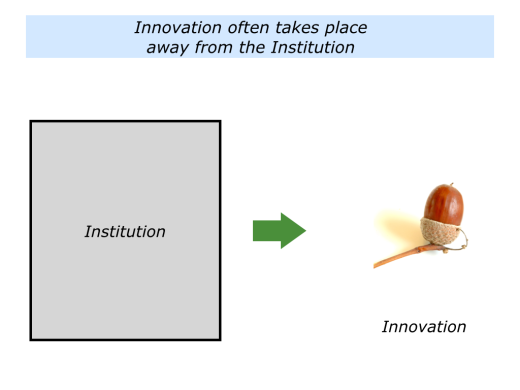
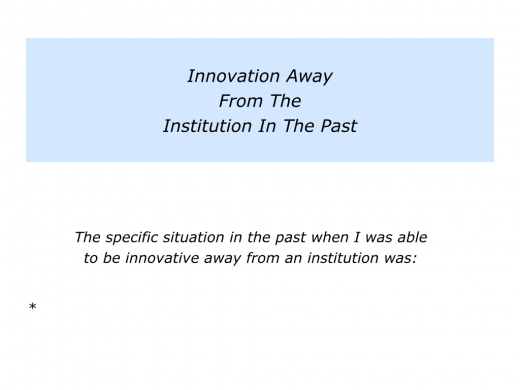
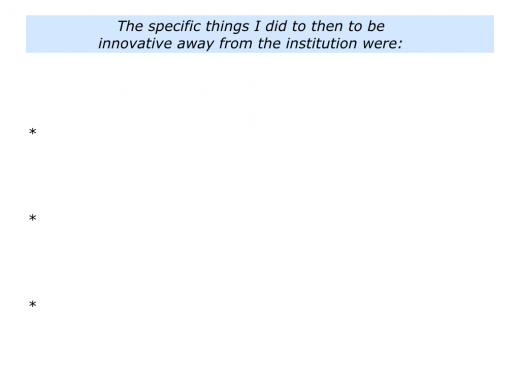
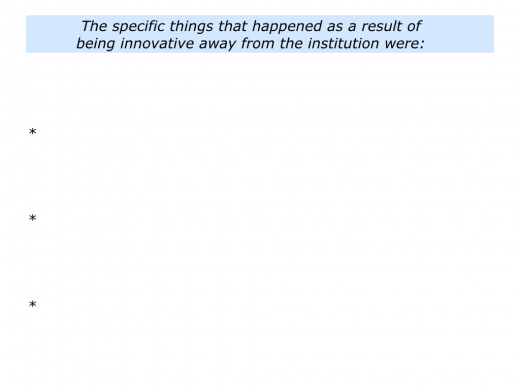
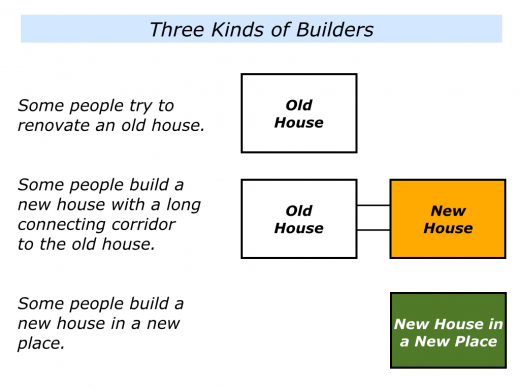
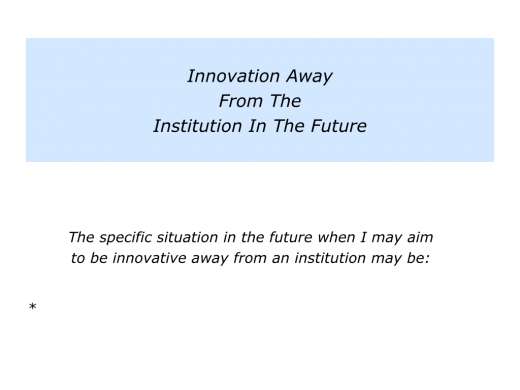
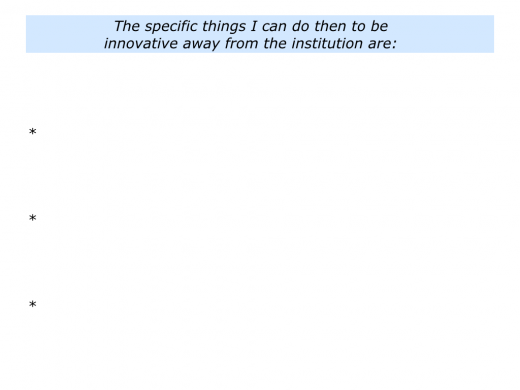
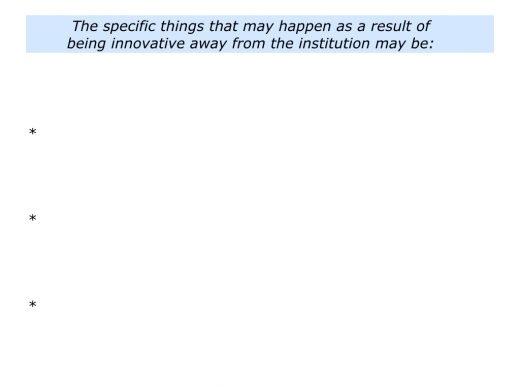




Leave a Reply